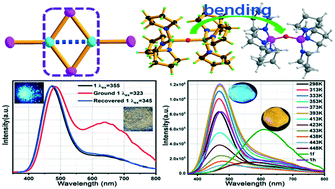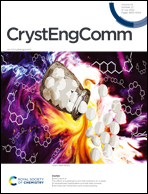Sensitive luminescence mechanochromism and unique luminescence thermochromism tuned by bending the P–O–P skeleton in the diphosphonium/iodocuprate(i) hybrid†
Abstract
Two new copper(I) iodide-based hybrids, i.e. (Py3P–O–PPy3)(Cu2I4) (1) and (Py3P–O–PPy3)(Cu4I6) (2) (Py = pyrrolidine), have been prepared, in which the tripodal diphosphonium (Py3P–O–PPy3)2+ is in situ generated in the one-pot synthesis. The disordered (Cu4I6)2− tetramers are rare with two sets of tetracuprate centers. Interestingly, 1 exhibits sensitive luminescence mechanochromism, which is ascribed to the disturbed cuprophilic Cu⋯Cu interactions and the crystalline packing adjustment by destroying C–H⋯I hydrogen bonds during mechanical force. In particular, the luminescence thermochromism is unique, whose fluorescence intensity is strengthened with the elevated temperature. This could be due to the S2–S1 internal conversion on the linear P–O–P backbone, which will be bent upon heating. Simultaneous luminescence thermo/mechanochromism can also be monitored in 1. However, no luminescence thermo/mechanochromic performances can be detected in 2, so the luminescence thermo/mechanochromism of 1 could be quenched with DMF. The conclusions in this work might provide a new large-scale synthesis strategy for intelligent responsive luminescent materials.



 Please wait while we load your content...
Please wait while we load your content...